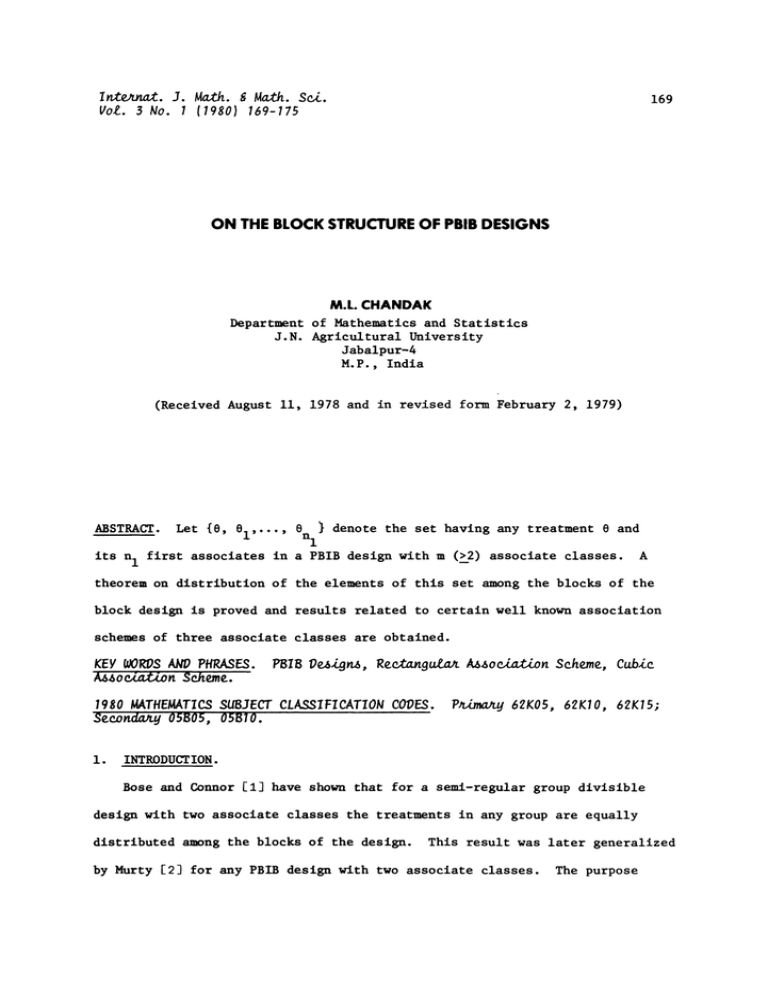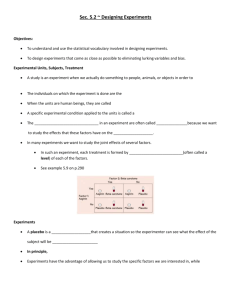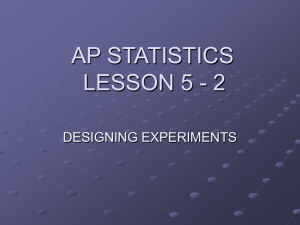8nl} 81,..., a THE BLOCK STRUCTURE
advertisement

I nteat. J. Math. a Math. Sei.
Vol. 3 No.
(1980) 169-175
169
ON THE BLOCK STRUCTURE OF PBIB DESIGNS
M.L. CHANDAK
Department of Mathematics and Statistics
J.N. Agricultural University
Jabalpur-4
M.P., India
(Received August ii, 1978 and in revised form February 2, 1979)
ABSTRACT.
its n
Let {8,
81,...,
8nl}
denote the set having any treatment 8 and
in a PBIB design with m (>_2) associate classes.
I first associates
A
theorem on distribution of the elements of this set among the blocks of the
block design is proved and results related to certain well known association
schemes of three associate classes are obtained.
KEV WORS AN PHRASES.
Ao eition Scheme.
PBIB Pign, ReeangZar Aoeation Scheme, Cubic
1980 MATHEMATICS SUBJECT CLASSIFICATION CODES.
See.ondary 05B05, 05BI O.
i.
Primary 62K05, 62K10, 62K15;
INTRODUCTION.
Bose and Connor [1] have shown that for a semi-regular group divisible
design with two associate classes the treatments in any group are equally
distributed among the blocks of the design.
This result was later generalized
by Murty [2] for any PBIB design with two associate classes.
The purpose
170
M.L. CHANDAK
of this note is to generalize his theorem for PBIB designs with
m(>_2)
Some connected results for three associate PBIB designs
associate classes.
are then obtained in section 5.
2.
ASSOCIATION SCHEMES AND PBIB DESIGNS.
Given
v
1,2,..., v a relation satisfying the following
treatments,
conditions is said to be an association scheme with
m
classes:
(a) Any two treatments are either ist, 2md,..., or m th associates, the
relation of association being symmetric, i.e. if treatment
associate of treatment 8, then 8 is the
() Each treatment has
nl,
i th
is the
i th associate of treatment
i th associates, the number
n
i
being independent
of the treatment taken.
(c) If any two treatments
of treatments which are
i
PJk and
are
and
j th associates of
is independent of the pair of
The numbers
v, n i,
association scheme.
i th associates then the number
i
Pjk’
k th associates of 8 is
and
i th associates
and 8.
I <_ i, j, k <_m, are the parameters of the
If we have an association scheme with
we get a PBIB design with
r replications,
b
m- classes, then
blocks, and block size
based on the association scheme provided we can arrange the
b
treatments into
blo@ks such that
(i)
k
each block contains
distinct treatments
each treatment is contained in
(iii)
occur together in
if two treatments
and
blocks (not all
%i’s
%’i
independent of the particular pair of
3.
v
k
i
are
r
i
blocks
th.associates, then they
equal), the number
th associates
%i
being
and 8 (I < i < m).
SOME KNOWN ASSOCIATION SCHEMES WITH THREE ASSOCIATE CLASSES
(a) Cubic association scheme.
Let there be
2,..., s).
(cf. Raghavarao et al [:] ).
3
v-- s treatments denoted by (a,8,V)* (,8,Y,
We define the distance
i,
between two treatments (a,8,V) and
BLOCK STRUCTURE OF PBB DESIGNS
8
171
to be the number of non-null elements in (
7
u’,
8 ).’
7
7
Any two treatments are Ist, 2nd or 3rd associates according as
i, 2, or 3
respectively.
(b) Rectangular association scheme.
If the treatments
rectangle of v
v
v
I.
v
2
Vartak, [6], Shah [5] ).
can be arranged in the form of a
rows and v columns, then the first associates of any treat2
I
(v2-1) treatments of the
(Vl-i) treatments of the same
ment are the other
same row, the second associates
are the other
column and the remaining
(v2-1)
(vl-i)
treatments are the third associates.
The reader may consult the references for examples of schemes and their
parameters.
4.
DISTRIBUTION OF THE
(nl/l)
TREATMENTS (VlZ. ANY TREATMENT 8 AND ITS n
FIRST ASSOCIATES) AMONG THE
Let 8 be any of the
first associates of 8.
occur in the
THEOREM.
m
i
Plt
t=l
At
b
BLOCKS OF THE DESIGN
treatments and let 8 I, 8
2
v
From among these
If in any PBIB design with
(nl
+l)r
n
I
(nl
(n + i)
I
1 2,..., b).
j th blohk (j
+l)k
v
i
be the n
e.
I
treatments
We now prove the following:
m(>__2)
2X
8nl
treatments let
associate classes
(4.1)
1
(nl+l)k is divisible by v. Further every block of
(+l)k/v treatments among the (nl+l) treatments
then
PROOF.
1
the design contains
We have
b
(4.2)
b
J=l
(ej
t=l
Plt
Xt
(4.3)
.
172
b
Defining
b
j=l
(ej-e)
b
-I
e
j_-
.
Now we have
M.L. CHANDAK
(n
J
l+l)k/v.
2
b
b
2
j=l
+
i)
ej (ej
b
ej
m
n
i
+
i
=i
Therefore
be integral
e
A +
Plt
e
I
v
e
2
from (4.1)
0.
(nl+l) r
.v
(nl+l) k
b
Since
V
ej(j
1,2,..., b) must
(nl+l)k.
divides
This completes the proof of the theorem.
5.
APPLICATIONS IN PBIB DESIGNS WITH THREE ASSOCIATE CLASSES.
Let N
or
0
(nij)
be the v x b incidence matrix of the design, where
according as the i th treatment occurs in the
j th
nij
block or not.
(a) Designs based on cubic association scheme.
Raghavarao et al (1964) obtained the characteristic roots of NN’
of such designs,
Let
P0’ PI’ P2’
+ 3(s-l)A I +
P0
r
P1
r +(2s-3)
P2
r
P3
r- 3A
+
1
(s-3)l
1
+ 3A 2
and
P3
denote these roots, then we have
3(s-i)22 + (s-i)33
+ (s-l) (s-3) 2
(2s-3)2
A
rk,
(s-l)2 3
+ (s-1)A 3
3.
We prove the followlng:
THEOREM 5.1.
_v_
k
i=
3s(s-l)_
(3s_2) 2p0
If in any PBIB design based on cubic association scheme
(5s_4)Pl+8(s_l)2P2+(s_l)2(3s_4)P3
i
BLOCK STRUCTURE OF PBIB DESIGNS
3
(3s-2)k is divisible by s
then
Further every block of the design contains
3
(3s-2)k/s treatments from among the
PROOF.
3
t=l
i
Pit
173
(nl+l)
treatments
e, el, e2,...,en
1
Condition (4 i) reduces to
r
t
(nl+l) (nl+l) k
n
I
L- i-J
v
2%1
In cubic association scheme one can easily see
1
1
i
n
3(s-l)
0.
s-2, PI2
2(s-l),
Pll
I
So, we have
(s_2)A 1 +
PI3
{ (.3.s-2)k i
r(3s-2)
2(s_i)2
3(s-l)
Substituting the values of
2
v
AI and A2 from (5.1)
I
and thereafter some simpli-
An appeal to the Theorem of section
fications lead to (5.2).
4
completes
the proof.
EXAMPLE:
23
consider v
8, then the treatments are (III) (112)
(122) (211) (212) 221) (222).
v
8
=i;
3,
3
121)
The scheme parameters wll be
P-’k3
Pjk
2
0
Pk
0
0
The design with parameters
b
6
r
3
k
4
AI
i
2
i
%3
3
satisfies the requ/rements of the theorem and therefore allows even dletriution
of a given treatment and its first associates among the
seen from the following;
B
B
B
I
2
3
(111, 112, 222, 221)
B
iii, 121, 222, 212)
B
(Iii, 211, 222, 122)
B
4
5
6
(112, 122, 221, 211);
(112, 212, 221, 121);
(121, 122, 211, 212);
blocks, as can be
174
M.L. CHANDAK
(b) Designs based on rectangular association scheme.
Vartak (1959) as pointed out in Saha (1966) proved that the
characteristic roots of
NN’
(A2- A3)’ P2
+ (v2
r- A
2
of this design are
i)
(i- 3 )’
If in a PBIB design based on rectangular association scheme.
THEOREM 5.2.
then k is divisible by v
Further every block of the design contains
I.
k/v treatments among the (n + i) treatments e
I
I
PROOF.
PI r %1 + (Vl -i).
rI- %2 + 3"
rk,
P0
P3--
Here we have n
I
v
I
i,
2
I
2,
v
Pll!
2
,..,
e1
enl
i
PI2
0.
P13
The
Theorem can be proved similar to previous theorem.
EXAMPLE 1.
0
Pjk
I
Let v
2 x 5
Pjk
0
0
I0
then n
I
4
n
2
i
n
3
4 and
0
0
Pjk
are the scheme parameters.
The design with parameters
b
i0
r
k
4
AI
i
4
A2
A
i
3
satisfies the requirements of the theorem and therefore the set consisting
of a given treatment and its first associates is evenly distributed among
the blocks, which can be seen:
1 2 6 7 ),( 1 4 6 9 ),( 2 3 7 8 ),( 2 5 7 10 ),( 3 5 8 10 );
( 1 3 6 8 ),(1 5 6 10 ),({2 4 7 9 ),( 3 4 8 9 ),( 4 5 9 10 ),
EXAMPLE 2.
Let v
3 x 4
12
then n
I
3
n
2
2
n
3
6 and
BLOCK STRUCTURE OF PBIB DESIGNS
Pjk
0
2
i
0
Pjk
175
0
i
P-’k
are the scheme parameters.
Any treatment with its first associates are evenly distributed among the
blocks of the design with parameters b
12
r
k
3
%1
0
2 %3
i
and the blocks are
6 l ),( 2 5 2 ),(
1 7 12 ),( 2 7 9 ),
s
0 ),( 4
3 6 12 ),( 4 6 9
i 8 i0 ),( 2 8 ii ),( 3 8 9 ),
ACKNOWLEDGMENT.
s
);
);
4 7 i0 ).
The author is grateful to the referee for his valuable
suggestions for the improvement of the earlier draft of this paper.
REFERENCES
Combinatorial properties of group divisible
designs, Ann. Math. Stat. 23(1952) 367-383.
i.
Bose, R. C. and Connor, W. S.
2.
Murty, V. N. On the block structure of PBIB designs with two associate
classes, Sankha 26(1964) 381-382.
3.
Raghavarao, D. and Chandrasekhar Rao.
(1964) 389-397.
4.
Shah, S. M. Bounds for the number of identical blocks in incomplete block
designs. Sankhya 38(1976) 80-86.
5.
Shah, S. M. On the block structure of certain partially balanced incomplete block designs, Ann. Math. Stat. 37(1966) 1016-1020.
6.
Vartak, M. N. The non-existence of certain PBIB designs, Ann. Math. Stat.
30(1959) 1051-1062.
Cubic designs, Ann. Math. Stat. 35






